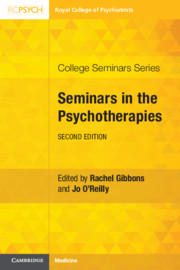Book contents
- Seminars in the Psychotherapies
- College Seminars Series
- Seminars in the Psychotherapies
- Copyright page
- Reviews
- Contents
- Contributors
- Foreword
- Preface
- Part I Therapy Theory and Practice
- Part II Applied Psychotherapeutic Thinking
- Section 1 Psychological and Psychodynamic Approaches to Psychiatry
- Section 2 Work in Practice
- Section 3 Contemporary Developments
- Index
- References
Section 3 - Contemporary Developments
from Part II - Applied Psychotherapeutic Thinking
Published online by Cambridge University Press: 27 May 2021
- Seminars in the Psychotherapies
- College Seminars Series
- Seminars in the Psychotherapies
- Copyright page
- Reviews
- Contents
- Contributors
- Foreword
- Preface
- Part I Therapy Theory and Practice
- Part II Applied Psychotherapeutic Thinking
- Section 1 Psychological and Psychodynamic Approaches to Psychiatry
- Section 2 Work in Practice
- Section 3 Contemporary Developments
- Index
- References
- Type
- Chapter
- Information
- Seminars in the Psychotherapies , pp. 337Publisher: Cambridge University PressPrint publication year: 2021

